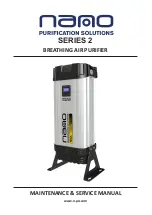
YORK
Start-Up & Operation Guide | 5587001-YSG-A-520
53
Operation
• When the system check is satisfactory, the con-
troller enters the pre-purge cycle
• During the pre-purge cycle, the controller en-
sures the APS opens and closes at the cor-
rect settings
• When the pre-purge cycle is satisfactory, the con-
troller enters the ignition cycle
• The inducer enters its light-off setting, typi-
cally high speed
• The direct spark ignition (DSI) module and
the spark ignitor energizes
• The 2-stage gas valve opens, allowing gas
flow
• The burners ignite and the controller receives
flame rectification from the flame sensor
• The spark ignitor remains active for the dura-
tion of the ignition cycle regardless of flame
status
• When flame rectification is not estab-
lished during the ignition cycle, the con-
troller repeats the above sequence up
to three times
• After three failed ignition attempts, the
controller enters a 1-hour lockout
•
When flame rectification is established, the con
-
troller enters a warm-up cycle to ensure flame sta
-
bilization and to reduce condensation forming in
the heat exchanger
• After completing the warm-up cycle, the controller
enters the run cycle
• During the run cycle, the burner firing rate
and draft inducer speed are determined
based on the heating demand sent via Mo-
dus from the controller
• Two firing stages are available: low and high
• The run cycle terminates when
• The heating demand is removed
• Any of the gas heat safeties open
• The control reaches its maximum run-
time of 6 hours. When this limit is
reached, the controller terminates the
run cycle and immediately re-enters the
heating operation when a heating de-
mand still exists
• After terminating the run cycle, the 2-stage gas
valve closes and the inducer is controlled to the
light-off setting for a 45-second post-purge cycle
• After completing the post-purge cycle, the control-
ler enters the off cycle. In the off cycle, all outputs
are de-energized but all safeties are still monitored
Table 23: Staged Gas Heating Faults List
Display Code
Color
Description
11
RED
Flame is detected outside of normal operations by the prime burner flame rod.
12
RED
Prime burner exceeds a number of trials for ignition.
13
RED
Prime burner flame loss count exceeds a threshold.
14
RED
Prime burner gas valve is shorted to 24VAC.
15
RED
Prime burner modulation/staging failure. The failure indicates that the gas valve state is
low when it must be high, or it is high when it must be low.
21
RED
Flame is detected outside of normal operations by the split burner flame rod.
22
RED
Split burner exceeds a number of trials for ignition. Prime burner remains operational
when this failure is detected.
23
RED
Split burner flame loss count exceeds a threshold. Prime burner remains operational.
24
RED
Split burner gas valve is shorted to 24VAC.
25
RED
Split burner modulation/staging failure. The failure indicates that the gas valve state is
low when it must be high, or it is high when it must be low.
31
RED
Flame is detected outside of normal operations by the prime and split burner flame rods.
32
RED
Reserved for future use.
33
RED
Split burner flame loss count exceeds a threshold. Prime burner remains operational.
34
RED
Prime and split burner gas valve is shorted to 24VAC.
35
RED
Prime and split burner modulation/staging failure. The failure indicates that the gas
valve state is low when it must be high, or it is high when it must be low.
















































